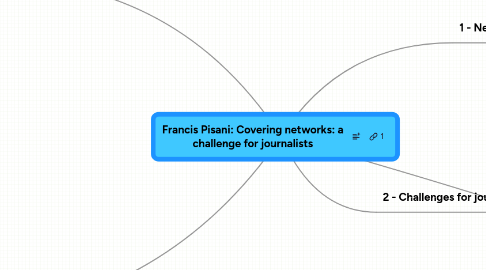
1. 3 - How to cover networks : A toolkit
1.1. Networks basics
1.1.1. • Elementary particles
1.1.1.1. • Nodes, links, hubs, and clusters
1.1.1.2. • Flows
1.1.1.3. • Swarming
1.1.1.4. • Leaderless
1.1.1.5. • Tipping points and structural holes. The positions that matter most.
1.1.2. • An emerging science
1.1.2.1. • Small worlds
1.1.2.2. • social networks
1.1.2.3. • network structure ans network functions
1.2. Exercice
1.2.1. • How would you cover the narcos?
1.3. Final discussion: How can we cover networks?
1.3.1. • Covering networks and network journalism
1.3.2. • Investigation journalism and networks
1.3.3. • Collaborative...
1.3.4. • Let's try to work together on the conclusion of these sessions.
2. References
2.1. Cases
2.1.1. • 9/11 attacks graph
2.1.2. • Nortwest blackout cascade effect explanation
2.1.3. • Fighting SARS
2.1.4. • Within a company
2.2. Articles
2.2.1. Fritjof Capra ITV
2.2.2. Article about medieval France
2.2.3. Mindjet On VsualThinking
2.3. Books
2.3.1. Watts, Duncan, Six Degrees, The Science of a Connected Age
2.3.2. Benkler, Yochai The Wealth of Networks, How Social Production Transforms Markets and Freedom
2.3.3. Barabasi, Albert-Laszlo, Linked, The New Science of Networks
2.3.4. Shirky, Clay
2.3.5. Arquila, John, Ronfeldt, David Networks annd Netwars
2.3.6. Fritjof Capra
2.3.6.1. # 1997, The Web of Life
2.3.6.2. # 2004, The Hidden Connections: A Science for Sustainable Living
3. http://www.mindmeister.com/42988415/francis-pisani-covering-networks-a-challenge-for-journalists
4. 1 - Networks today
4.1. Networks we hear about today and how they are covered
4.1.1. • Al Qaeda, terrorists organization, narcos...
4.1.2. • Smart Mobs, impromptu political movements...
4.1.3. • Epidemics, SARS...
4.1.4. • Memes
4.1.5. • Blackouts and cascade effects
4.1.6. • The Internet, and the Web
4.1.7. • Social networks
4.1.8. • Production networks
4.1.9. • Mixed structures in hierarchical organizations
4.2. Are they more important? And why?
4.2.1. • An old social form rejuvenated by ICT
4.2.2. • The organization aspect: they are more efficient
4.2.3. • The infrastructure aspect: they are everywhere
4.2.4. • The cultural aspect: questioning hierarchies
4.2.5. • The knowledge aspect: an emerging science
4.2.6. • The hipe aspect: a tendency to see networks everywhere
4.3. Exercice
4.3.1. • In Mexican society find topics in which you see a network dimensions. Let's discuss.
5. 2 - Challenges for journalists
5.1. Coverage issues
5.1.1. • No headquarter
5.1.2. • No territory
5.1.3. • No "chief"
5.1.4. • No spokeperson
5.1.5. • Different kind of relationship (no belonging)
5.1.6. • Fluid organization
5.2. The problem with not understanding networks
5.2.1. • 2 case studies taken from recent news
5.2.1.1. Dubai assassination: Mossad only?
5.2.1.2. China vs Google: gvt + network of hackers
5.2.2. • Some problems:
5.2.2.1. • Understanding late
5.2.2.2. • Not understanding
5.2.2.3. • Not communicating
5.2.3. • Understanding networks, participation and the evolution of media
5.2.3.1. • P2P and horizontal communication
5.2.3.2. • Conversations
5.2.3.3. • Participatory media
5.3. Exercise
5.3.1. • Draw the network structure and flaws of a goup you know well. Compare with the hierarchical structure if possible.
